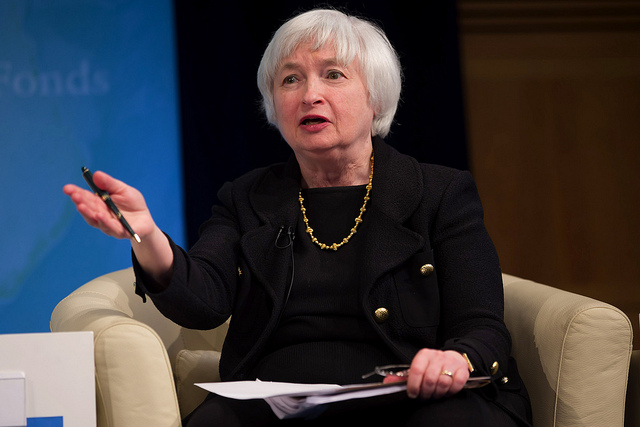Forbes Magazine ranks Angela Merkel the most powerful woman in the world. As German Chancellor, she is certainly the most visible woman leader. The magazine identifies Janet Yellen as the second most powerful woman in the world. Yellen heads the Federal Reserve Board, the U.S. central bank. She was previously Fed Vice-Chair before being nominated as Fed Chair by President Obama in 2013, and confirmed by Congress.
A head of government like Merkel has many constraints on what she can do or say. Corporations, bankers, the party program, ministers, supporters, the media, other countries, the opposition, intellectuals, voting blocs — all establish parameters for leadership. Central bank governors have fewer constraints, more independence in fact, than elected heads of government. But serious limits still exist on what leadership they can exercise.
Speaking to monetary policy insiders and specialists this past week at the annual Jackson Hole conference, Yellen questioned one of the main tenets of economic thinking. Yellen suggested that falling unemployment rates (the U.S. rate is down to nearly six per cent) did not necessarily signal an economic recovery. Slow wage growth — wage deflation — needed to be considered before cooling off the economy with tighter monetary policy.
The wage picture in the U.S. has been horrific for decades. Median wages for prime working-age American males (25-54) have been falling since 1972 as Bloomberg News headlined last year.
Analysts use “household income” to claim middle-class families are holding their own. Right. So long as women entered the workforce in increasing numbers, the fact that male wages were falling could be obscured by adding two wages together, and calling it a household. Fact: after a 25-year boom, growth ended in the early 1970s — increasingly, it has taken two median wages to sustain a middle-class lifestyle.
In her speech, Yellen pointed out that after 2008 when jobs were lost, wages for remaining workers did not decline. Companies wanted to retain core employees, not punish them because of adverse economic conditions and poor business results. She observed that in the upturn, wage increases were unlikely to spur inflation. New workers could not demand wage increases, and core workers produced productivity gains greater than their wage increases.
The type of reasoning is what economists call “efficiency wage” theory. Thirty years ago, Yellen showed why simplistic assumptions about how lowering wages lead to less unemployment did not hold up to close examination. With her husband (Nobel Prize winner George Akerlof) she co-authored a major contribution to efficiency wage theory known as the Akerlof-Yellen model, explaining wage inflexibility by expected productivity benefits.
Yellen told the Jackson Hole crowd not to expect that monetary policy was going to become restrictive at the first sign of wage increases.
This runs counter to the idea that wage increases spell price inflation and always need to be targeted by central bank policy, thinking that has dominated the financial world and conventional economics since the early 1970s.
Prior to her nomination as Fed Chair, Yellen was considered a dove, seeing monetary policy as an instrument to promote job growth. The vast majority of financial market observers and mainstream economists are monetary hawks who want policy to restrict inflation. As Yellen reminded the annual Jackson Hole monetary policy conference last week, the Fed has been mandated by Congress to pursue maximum employment as well as price stability.
The Federal Reserve was established in 1913 to bring order to the chaotic American monetary and banking world. In response to the Wall Street crash of 2008, the Fed has being using all the instruments of monetary policy to pump money into the banking system.
Market watchers are trying to figure out when the Fed Chair will decide to tighten the screws. While few want to follow debates over labour markets such as featured at Jackson Hole, all know they provide significant clues as to what the Fed Chair is thinking … and what the Fed will do.
The Bank of Canada was created in 1936 with a wide mandate “to mitigate economic fluctuations,” including in employment levels. Its mandate was redefined in the early 1980s to be solely about licking inflation. Indeed the Mulroney government tried to have this anti-inflation mandate included in its Charlottetown constitutional reform package.
At the moment, Germany under Angela Merkel is the most important proponent of austerity as protection against inflation. Janet Yellen has come forward as the most important voice, suggesting that wage deflation dampens economic recovery.
Duncan Cameron is the president of rabble.ca and writes a weekly column on politics and current affairs.




